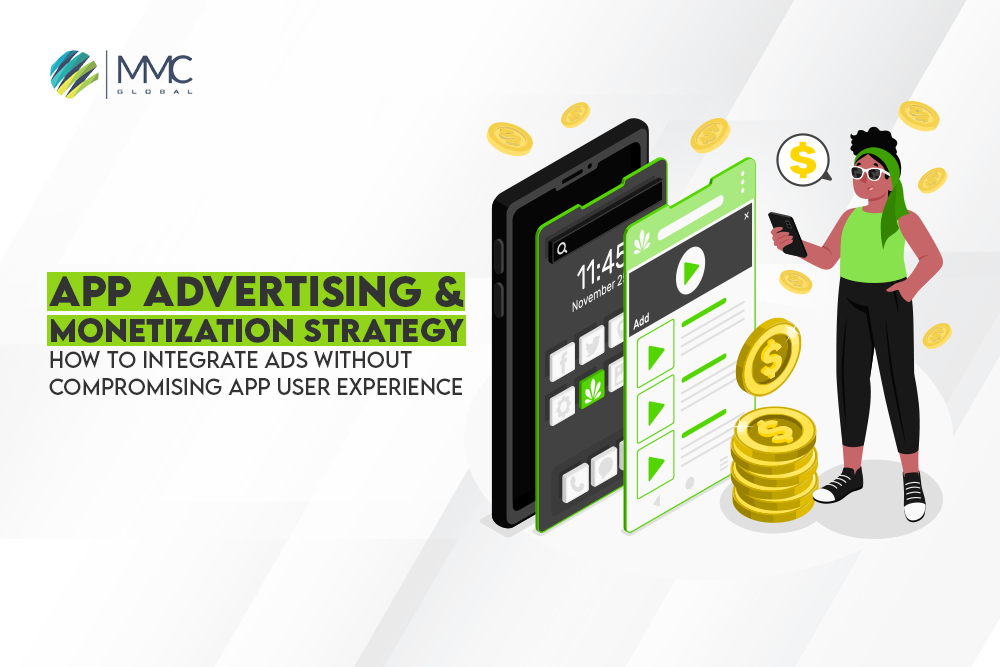App Advertising & Monetization Strategy – How to Integrate Ads Without Compromising App User Experience


App advertising helps generate additional monetization that fills up the investment you put in mobile app development. The market for app advertising is surging with rapid figures, which are projected to reach $352Bn in 2024. It becomes a consistent revenue stream for app owners offsetting the mobile app development costs.
However, adding ads to your app is not as simple as it looks like. Integrating ads requires an effective app monetization strategy into your app. In addition to this, these ads also do not adversely affect the app user experience. While building an app, the development team minimizes the clutter and creates a user-friendly experience without any extra stuff over the main screens. It will increase user engagement but it can also be intrusive if you do not follow the best practices for ad integration within the app. As a result, it can worsen the app user experience.
The ads are highly targeted and relevant to the user preferences that are fetched from data such as user search intent and user search history. The targeted app ads use AI & ML algorithms to monitor user browsing activity. That allows them to study user behavior, learn real-time searches, and prioritize ads for displaying during app usage. The app advertisement fetches the data and displays target ads that feel o personalized and seem like your phone is listening to your needs.
Types of In-App Advertising
There are various types of in-app advertisements and each has its benefits and suitability. Let’s dive deeper and understand the motive of each type.
Interstitial Ads/Full-Screen Ads
Interstitial ads are full-screen ads that come at a natural pause or during a transition within the app. These ads can be static (in the form of infographics) or video. It works best where the user engagement can be paused or can not divert primary focus. For example, a gaming app. Interstitial ads can show right after the level changes, or get rewards. However, it is not suitable for apps that can interrupt user experience or require quick access to content. These apps can be educational, productivity apps, or management apps as ads can distract the primary focus.
Playable Ads
It is a mini video ad that displays the demonstration of a product like how to use it. These ads can majorly be embedded in gaming apps, lifestyle apps, and entertainment apps. Playable ads aim to provide an instant overview of other apps to encourage users to download them. For example, a popular Candy Crush game has playable ads, showcasing other different gameplays that attract gamers to download more games. Playable ads are not advisable for productive apps which can cause disturbance in workflows.
Banner Ads
These ads are less intrusive and can be easily adjusted at the top or bottom of the app. Banner ads within the app are very confined and contentful which may make screens cluttered. Moreover, these ads are mainly used in informational apps like news apps where people actually focus on content and do not mind if any irrelevant content appears. In fact, the banner ads contain some informational content with functional CTA that redirects to the landing page.
Rewarded Ads
Rewarded ads are highly effective in gaming apps. They voluntarily allow users to watch and get some rewards like coins, weapons, unlocking milestones, or extra levels. These ads encourage users to get some cool rewards that maximize user engagement within in-game activity. These rewarded ads can only be suitable for entertaining apps but not for productive or management apps.
Pros and Cons Of App Advertisement
There are maximum pros and a few Cons of app advertising. Let’s have a look:
Pros
Highly Targeted Reach: App advertising is highly audience-oriented with a wide range of reachability. By fetching out data, including demographics, user preferences, and behavior, the app can personalize ads and display them according to the type of ad implementation.
Enhanced User Engagement: With rich media and playable visuals, ads enhance user engagement and maximize interaction along with capturing user attention towards the advertisement.
Boost Revenue: Allowing app advertisements helps you generate maximum revenue streams which offset the cost of mobile application development.
Reporting & Analytics: With the help of KPIs, the app owners can gauge the performance of an app by analyzing different key metrics including click-through rates, impressions, conversion rates, etc.
Cons
Intrusiveness: App advertising sometimes destroys the user experience by making a cluttered user interface or distracting from the focal point of using an app.
Privacy Concerns: For the sake of privacy, app users have some security concerns which is why they avoid irrelevant clicks.
Best Practices To Follow App Advertising
In order to get the maximum benefit from the app and advertisement, both the app owners and advertiser need to follow these practices.
For App Owner Aspect
To make the most out of it from your app, you need to optimize the user experience to attract and retain the app users. Choosing the right format for the ad, placing it in the right place, as well as monitoring the performance of the app can improve user experience.
Moreover, the app advertising also depends on the app’s relevancy. The user will not attract if the ads do not incorporate their interest. That is why studying user behavior, monitoring browsing history, and tracking demographic details is a must to showcase purposeful ads. Moreover, it will improve user engagement and have a high impact on revenue streams.
However, daily analysis is instrumental for app owners to measure the application and advertising performance. With the help of key app metrics like CTR, impressions, etc, app owners can effectively achieve the success rate to generate revenue.
For Advertiser
Reaching a wider target audience is the major goal of marketing and advertising agencies. Within app advertising, advertisers have to study the user preferences and prioritize demographics which lead to the right and intended audience.
Moreover, the advertiser must focus on quality content with the proper placement of CTA. It should redirect to the proper landing page to provide in-depth information about the product/services that you want to sell.
In fact, continuous testing with different content and visuals also impacts the ad performance. Apply A/B testing and gain deep insights into the diverse content to understand the ad interaction graph of the users.
Wrapping Up
App advertising and monetization strategy is a lucrative opportunity for app owners. It helps to generate acute revenue streams that cover your application development cost, make your app more reliable, and improve your app engagement. The more you can help generate business via app advertisement, the more you can get a commission with the advertisers.
If you are looking to invest in mobile applications and then build an effective monetization strategy, then connect with us. MMC Global provides end-to-end mobile app development services with a result-oriented app advertising and monetization strategy. Our developers have a good command of building clutter-free user interfaces by keeping your app’s sustainability in mind. Moreover, they open lucrative opportunities for app owners and take a futuristic approach to ad placement. Without further ado, let’s connect and build a profitable app beyond your imagination.



